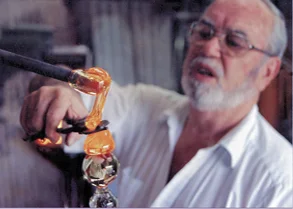Robert working a huge art vase
ABOUT US
Robert L. Hamon was one of the greatest glass artists in the world. He started blowing glass in his father's glass factory at the age of 10. His life was devoted to glass. Robert's art glass has been exhibited widely, and he has won numerous awards for his outstanding blown glass creations. Glass sculptures, marbles, vases and paperweights were among his specialties. And he was equally comfortable blowing figurines to wow a group of school children, or a finely honed paperweight to satisfy the demands of an avid paperweight collector. Bob had a great eye for color, shape and design, and his glassblowing skills were second to none. He was a true glass master.
Robert came from a glass family. His parents, Okey and Mamie Hamon, along with Orville Hamon and Otis LeRoy Hamon, started a glass business during the Great Depression. It was originally called the Scott Depot Glass Company and later became the Hamon Glass Company. No one knows how they were able to succeed during such difficult times. Okey was a preacher, as well, and spent his spare time writing sermons and preaching at various area churches. And, he dabbled in real estate, which may have helped fund the glass enterprise. Okey B. Hamon introduced Robert to glassblowing at an early age. Robert's first job in the company involved blowing lamp chimneys for parts of the country that did not have electricity, and the war effort.
Robert's glassblowing career was interrupted by a stint in the U.S. Navy in WWII. He was stationed at the Norfolk, Virginia naval base, where he held down an administrative job, played football, baseball and basketball. While Bob and his brother, Leo, were in the Navy, Bob's brother, Richard helped keep the enterprise going at the Oklahoma plant, to which the the family had moved. He blew glass, especially lamp chimneys, unloaded chemicals from boxcars, swept the glass-littered floors at night, packed shipments and repaired equipment. Blowing chimneys was very difficult and demanded a high level of skill. Few teenagers were capable of such feats.
The family moved back to WV as Robert returned home from the Navy. Robert was instrumental in developing decorative color glassware. Robert's glass education continued under the tutelage of various accomplished glassblowers. He loved blowing glass and proved to be a natural, becoming an accomplished glassblower by the age of 20 or 21. Among the more popular decorative pieces that Robert was developing were candy vases, punch bowls, pitchers and glasses in blue, amber, crystal, white and green. Incidentally, green was the number one color produced by Hamon Glass. Robert was around 24 years of age.
During the next several years, Robert continued to develop the Hamon Glass line, and gradually moved into art glass. When his parents retired, Robert took over as President of Hamon Glass Company, the company his parents founded, and slowly transformed the business from communion glasses and colored glass gift ware to a more artistic product line.
In time, Robert's name became synonymous with Hamon Glass, and in his mid-forties he closed the factory and opened the Hamon Glass Art Studio. There Bob focused his energy on crafting collector's paperweights, marbles and art pieces. It was there that Robert experimented, dreamed and dared to push the boundaries.
Robert's brother, Richard helped Robert design paperweights, and other art glass pieces, such as the hand-cut rose paperweight. Also, Richard made Robert's crimps, various glassblowing tools, and improved glass processes, which helped Robert save time and labor. Eventually, Robert became most noted for his collectible paperweights, especially the sulphides, and weights like the Hamon rose.
Bob's fame was related to his ability to make such a wide variety of glass pieces, whereas many glassblowers can only make a few types of glass. In addition, Bob's finishing was excellent. Handles were straight, rough spots were smooth and pieces were finished to a high standard of excellence.
All in all, Robert's crystal was beautiful and clear, his colors vivid, and his attention to detail extraordinary. The sheer volume of the high-quality glass that he made in his lifetime is simply stunning. Free-form sculptures and paperweights were imaginative, understated and elegant.


